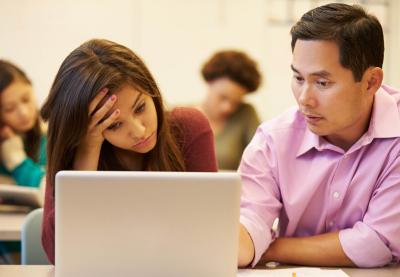When I was in middle school, studying current events meant that, on Tuesdays, we’d bring in articles we’d clipped from a newspaper and summarize them using the five W’s: What happened? When? Where? Who was involved? Why? A few of us would share, and then we’d return to the War of 1812 or Westward Expansion or whatever we were studying.
It’s no longer possible to relegate current events to Tuesdays. Not when the news is Charlottesville. Or Flint. Or Ferguson. Or Sandy Hook. Each time a public traumatic event occurs, teachers create resource guides that, at this point, have become too familiar: a collection of fact sheets, news links, timelines, interviews, tips on leading difficult conversations, referrals for students in crisis. School hasn’t even started, and I’m already overwhelmed by the responsibility of teaching traumatic events. What will the next resource guide be about?
For an alternative to discussing news only on a set day, or only when events are so traumatizing that it’s impossible to discuss anything else, we might look to place-based education as a model. As David Sobel explains in Place-Based Education: Connecting Classrooms & Communities, this model means “using the local community and environment as a starting point to teach concepts in language arts, mathematics, social studies, science, and other subjects across the curriculum.”
We can take that model and expand it as we consider current events in the classroom. If place-based education makes “here” the focus, perhaps a current events-based education means focusing on “now”—that is, empowering students to use the concepts and processes they learn across the curriculum to help them understand and act against injustices.
A now-based education that empowers students begins with helping them discover their own values that make them care about injustices in the first place. After a traumatic event, what if students learned to see their feelings as signposts that point toward their values? We feel angry when something we value is violated, sad when something we value is lost, afraid when something we value is threatened, and guilty when we ourselves threaten what we value.
After an event like Charlottesville, have your students write privately about their feelings. Then ask them to read over their writing and underline things they care about. For example, a student who writes, “I’m afraid that white supremacists will march through my town too, and I’m angry that people of color are unsafe in this country” might underline “my town,” “people of color,” and “this country.” If these are the people and places they care about, how will students approach them? What can they do this afternoon, this week, this month? And what are they learning in our classes that will help them take those actions?
To help students use their learning to move toward action, we could ask questions like:
How is this event connected to [an issue, time period, or phenomenon they’re studying]?
John Muir famously wrote in My First Summer in the Sierra, “When we try to pick out anything by itself, we find it hitched to everything else in the Universe.” What people, places or patterns are both the current event and your current unit hitched to? If the problems are connected, could the solutions also be connected? What can students learn from a different historical moment, cast of characters or field of study?
We can also ask this question:
How could learning how to [perform a skill they’re learning] help you act for justice in this situation?
Maybe persisting at a difficult math problem will help students persist at calling a senator who’s silent on gun control. Maybe doing basketball drills in P.E. will teach them the teamwork required for planning an anti-pipeline action. As English teacher Jamilah Pitts writes of her post-Charlottesville teaching plans, we can help our students see their assignments as opportunities to develop skills they’ll need to act against injustice.
In creating a now-based curriculum, let’s also study moments of justice, equity and solidarity. Good news might not make headlines, but students need to know what positive change looks like and how people come together to work for it. Not only can learning about positive developments feel reenergizing in the moment; it can also help students build the knowledge and skills to create the community and future they want for themselves. Isn’t that why they’re in school?
Porosoff teaches English at the Ethical Culture Fieldston School and is the author of Curriculum at Your Core and the upcoming EMPOWER Your Students: Tools to Inspire a Meaningful School Experience.

